In an era where tactical autonomy is shaping the future of warfare, India has made a bold leap forward with the introduction of the FWD-LM01, an export-ready loitering munition designed and developed by Flying Wedge Defence & Aerospace (FWDA). Unveiled at the Paris Air Show 2025, this indigenous drone offers a perfect blend of stealth, portability, and AI-powered precision, marking India’s serious entry into the global long-range drone warfare domain.
But what exactly is the FWD-LM01? Why is it such a game-changer for India’s defence sector? And how does it stack up against global competitors? Let’s break it down.
What is FWD-LM01?
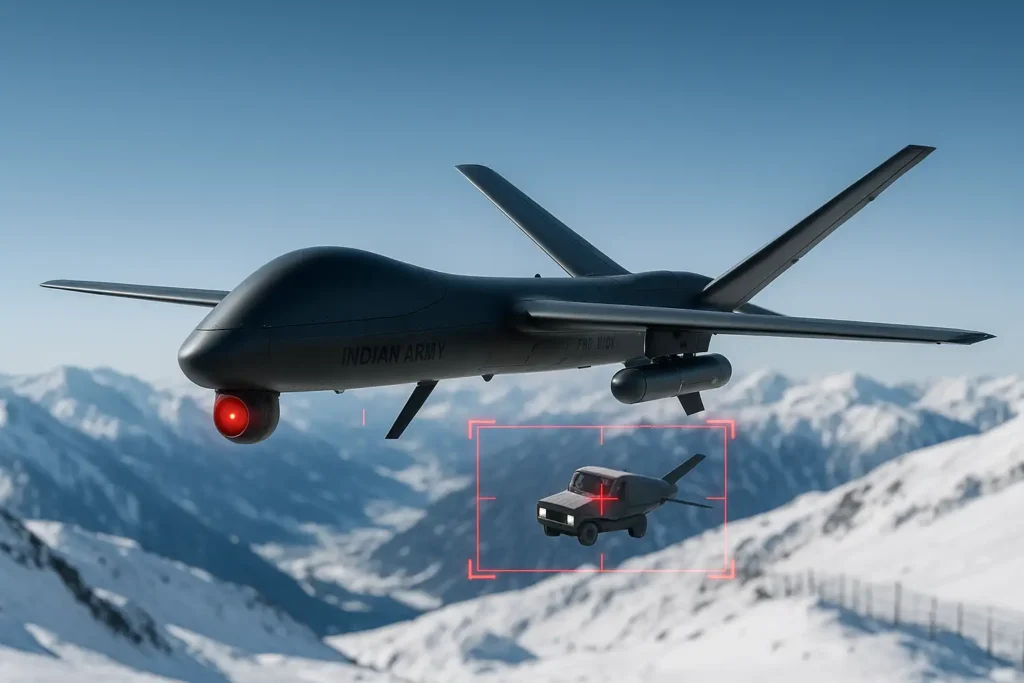
The New Face of India’s Loitering Munition Arsenal
The FWD-LM01 is a lightweight, long-range loitering munition drone with a range of 100 km and a warhead payload of 2 kg. Designed for precision strike missions in hostile territory, it uses electro-optical (EO) and infrared (IR) sensors to identify, lock onto, and destroy enemy targets with surgical accuracy.
But unlike traditional drones, the FWD-LM01 doesn’t return—it is designed to loiter over targets and then dive in for a kamikaze-style attack. This loiter-and-strike approach enables it to neutralise high-value targets such as radars, mobile command posts, and enemy convoys, without risking human lives.
Who Built It? Inside Flying Wedge Defence & Aerospace
Bengaluru’s Startup That Took on the Big Players

Flying Wedge Defence & Aerospace (FWDA), based in Bengaluru, is the young and ambitious firm behind FWD-LM01. Founded in 2022 by Suhas Tejaskanda, FWDA has quickly positioned itself as a major innovator in AI-powered drone technology.
Their vision? To design and manufacture indigenous drones that are agile, intelligent, and exportable, aligned with Atmanirbhar Bharat and global demand.
Before this, FWDA made headlines for its FWD-200B unmanned bomber, which completed its maiden flight in 2024. With FWD-LM01, they’ve shifted focus to the tactical drone warfare segment, offering a highly scalable system built entirely in India.
FWD-LM01 Drone Specifications
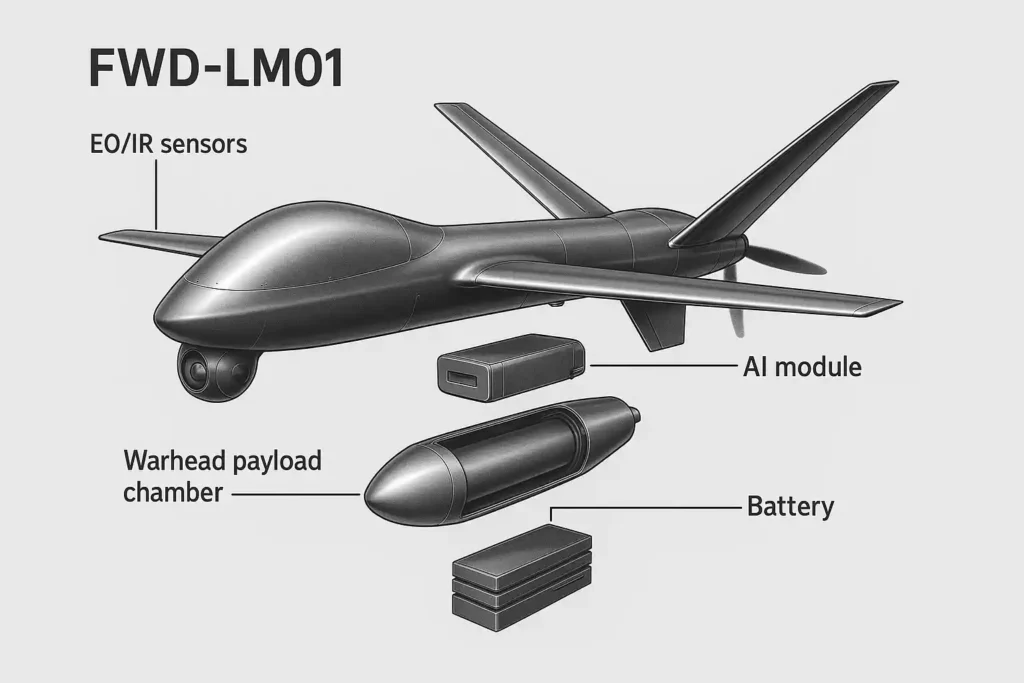
Compact Yet Capable: Built for Field Warfare
- Take-off weight: ~6 kg
- Wingspan: 2 metres
- Range: 100 km (linear)
- Endurance: Up to 1.5 hours loitering
- Operational altitude: ~17,000 ft
- Warhead payload: 2 kg
- Sensors: EO + IR for day/night operation
- Assembly time: Less than 5 minutes (tool-free)
What sets the FWD-LM01 apart is its man-portable and rapid-deploy design. It can be carried by a single soldier, assembled without tools, and launched within minutes, making it perfect for rapid-response operations and asymmetric warfare.
AI-Powered Autonomy & Smart Strike Capability
From Visual Intelligence to Precision Kill
At the heart of the FWD-LM01 lies its AI navigation and targeting system. Using onboard computer vision, it can autonomously patrol a designated area, identify threats, and engage with pinpoint accuracy.

Thanks to its EO/IR sensors, it can operate under low visibility and during night-time, offering complete tactical flexibility. This makes it highly effective for missions such as:
- Suppression of Enemy Air Defences (SEAD)
- Cross-border tactical raids
- Real-time surveillance and dynamic targeting
Development Timeline of FWD-LM01
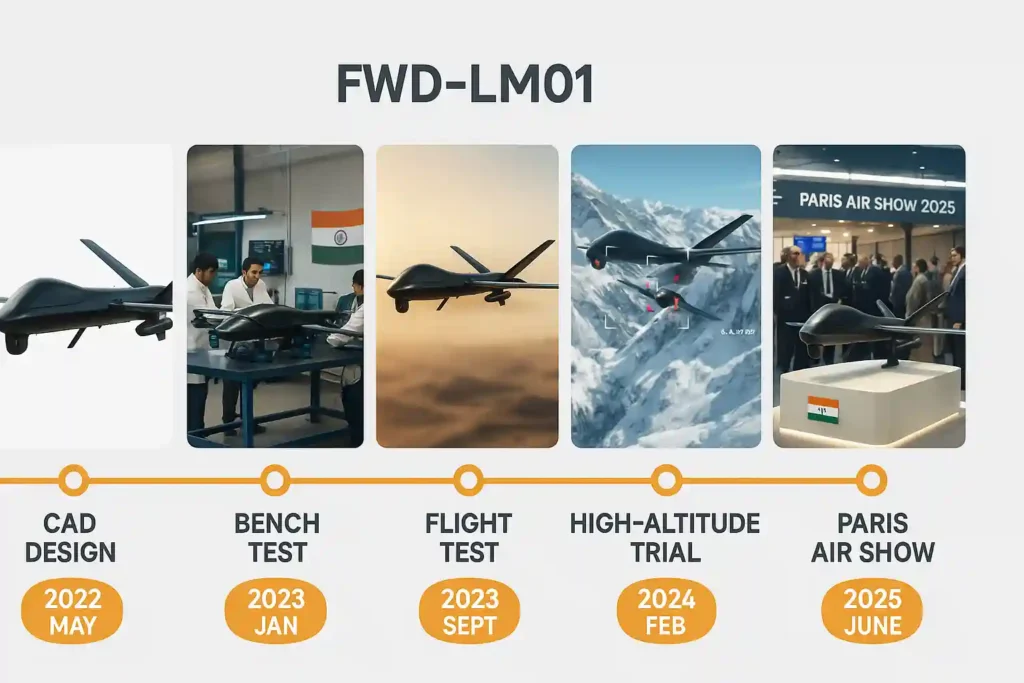
Built From Scratch in India
FWDA designed and engineered the drone entirely in Electronic City, Bengaluru. Every phase—CAD design, structural prototyping, payload testing, AI algorithm training—was completed in-house.
Key Milestones:
- 2023: Conceptualisation and early CAD models
- Early 2024: First test flights and autopilot tuning
- Q3 2024: High-altitude flight trials up to 17,000 ft
- June 2025: Unveiled globally at the Paris Air Show
- Q4 2025: Scheduled for live explosive testing
This makes FWD-LM01 India’s first fully indigenous 100 km loitering munition system to be showcased at an international air show.
Paris Air Show 2025: A Defining Debut
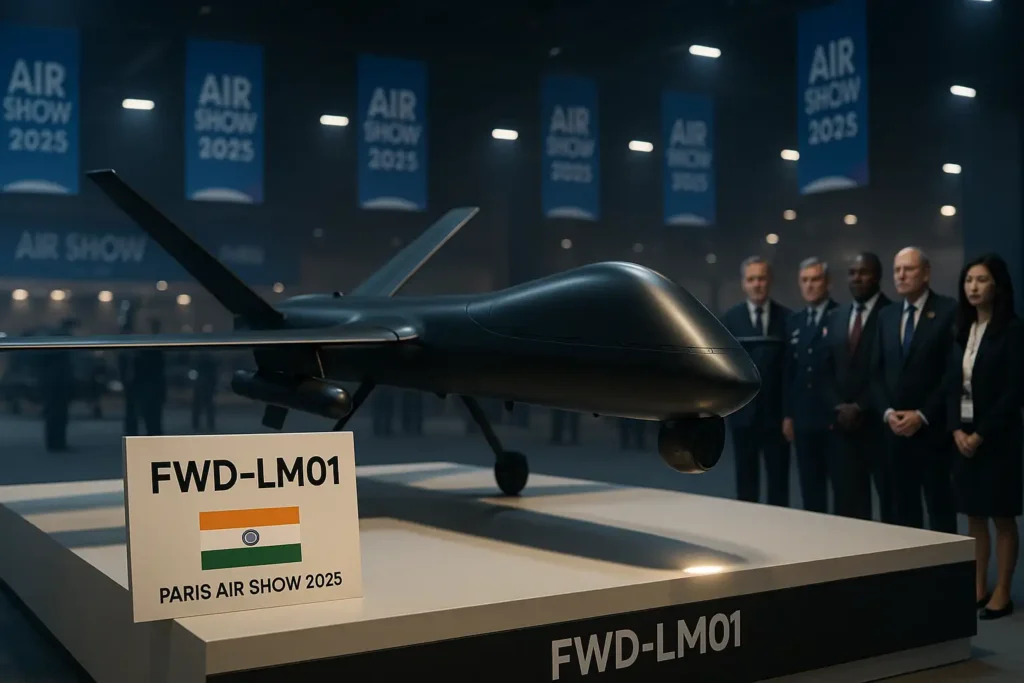
Why the World Took Notice
The drone made headlines when it debuted at the 55th Paris Air Show, one of the largest defence aviation exhibitions in the world. It stood out for its:
- Compact yet lethal design
- Export-ready engineering
- AI-guided strike autonomy
This marked India’s strategic assertion on the global unmanned systems map, joining the ranks of countries like the US, Israel, and Turkey.
Strategic Significance of FWD-LM01
From Local Innovation to Global Competitor
India’s previous loitering munitions, such as the ALFA-S and imported Warmate drones, were limited to under 40 km range. The FWD-LM01 is a significant leap, offering:
- Extended reach (100 km)
- Smart targeting
- Quick deployment in combat zones

For the Indian Armed Forces, this allows deployment in mountain warfare, counter-insurgency ops, and border patrols, especially along the LAC and LoC.
From an export perspective, the drone offers affordable precision strike capabilities, perfect for developing nations needing autonomous firepower on a budget.
FWD-LM01 vs Imported Suicide Drones
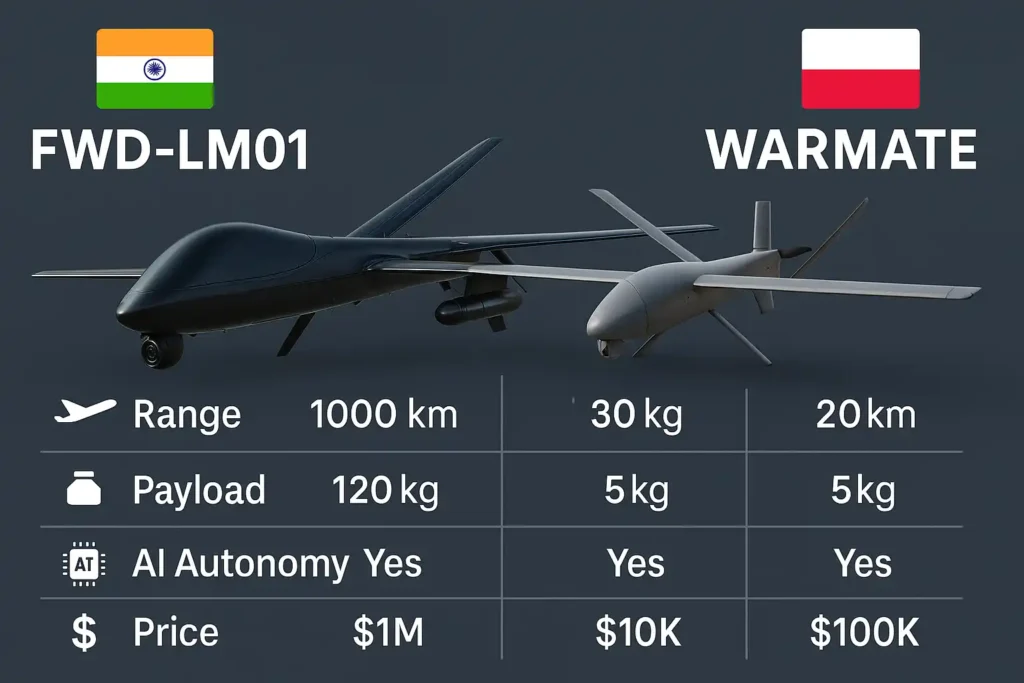
India previously relied on imported loitering drones like Poland’s Warmate and options from Israel or Armenia. However, FWD-LM01 delivers a homegrown edge:
- Range: 100 km (vs. 30–40 km on imports)
- Payload: 2 kg precision warhead (vs. 0.5–1 kg)
- Deployment: Under 5 mins, tool-free (vs. longer prep)
- AI Autonomy: Full AI + EO/IR sensors (vs. operator-reliant)
- Cost: More affordable, export-friendly
Crucially, it’s fully indigenous, ensuring operational self-reliance and wartime logistical ease.
Tactical Edge in Mountain Warfare (LoC/LAC Use)
The FWD-LM01 excels in India’s high-altitude battle zones:
- Altitude: Operates at ~17,000 ft—ideal for LAC/LoC
- Portability: Carried and launched by troops on patrol
- Sensors: EO/IR tech maps enemy posts in rugged terrain
- Loiter Capability: Circles ridgelines, strikes with precision even without stable GPS
It’s not just combat-ready, it’s terrain-ready—engineered for India’s most challenging fronts.
What Comes Next for FWD-LM01?
Certification, Live-Fire, and Expansion
While the drone has already passed flight tests, the final explosive trials are scheduled for late 2025 or early 2026. Once certified, FWDA aims to:
- Open up international sales under friendly bilateral frameworks
- Adapt the platform for swarm warfare scenarios
- Develop next-gen combat drones capable of targeting jets like the JF-17 and F-16
FWDA’s long-term plan includes building jet-powered unmanned fighters, data-linked drone swarms, and dual-use drones for agriculture, disaster relief, and border surveillance.
Final Thoughts: A Drone That Defines New Warfront Norms
The FWD-LM01 isn’t just another tactical drone—it’s a statement of intent. With smart targeting, 100 km range, rapid deployment, and indigenous design, it marks India’s shift from import dependence to innovation leadership.
For soldiers, it’s a lifesaving battlefield tool. For strategists, it’s an asset that shifts the balance in India’s favour. And for the world? It’s a clear sign that India is ready to lead the next wave of autonomous drone warfare.
FAQ (For Schema & Featured Snippets)
Q1. What is the range of the FWD-LM01 drone?
The FWD-LM01 has a 100 km linear range with up to 1.5 hours of loiter time.
Q2. Who manufactures the FWD-LM01?
It is developed by Flying Wedge Defence & Aerospace, a Bengaluru-based startup.
Q3. What is the payload capacity?
The drone carries a 2 kg warhead with EO/IR sensors for precision targeting.
Q4. Is FWD-LM01 ready for export?
Yes, it is designed as an export-ready system and showcased at the Paris Air Show 2025.
Q5. What makes it different from other Indian drones?
Unlike previous sub-40 km drones, it combines long-range, smart autonomy, and fast deployment in a lightweight package.
